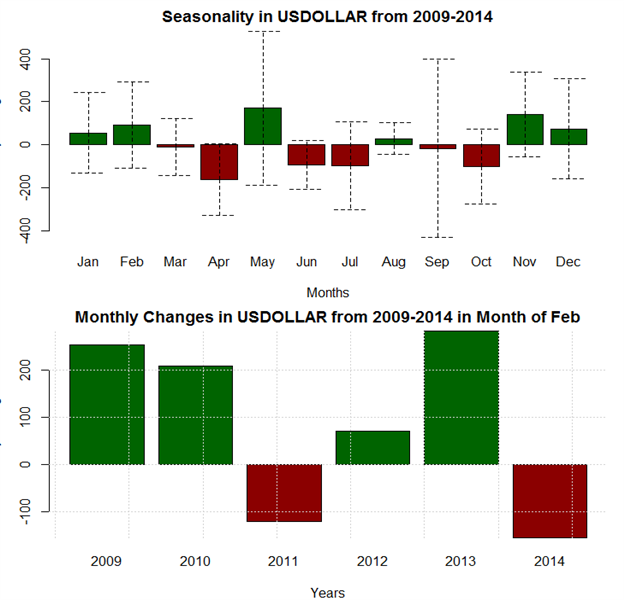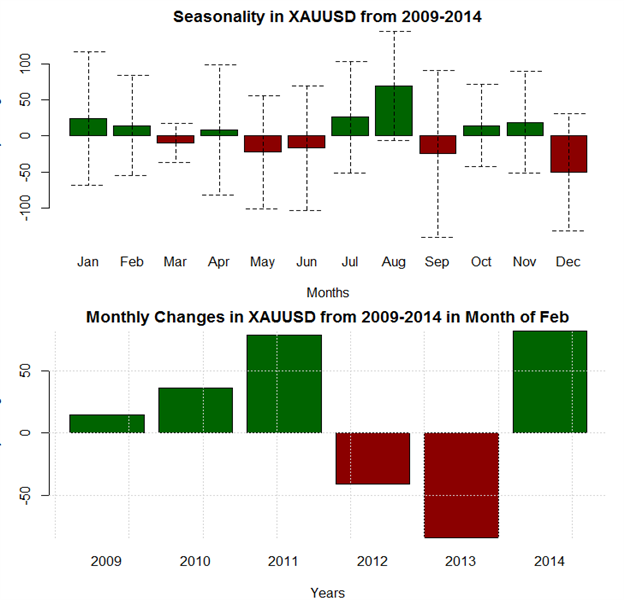February Forex Seasonality Sees Slight Gain for US Dollar Caution Though
Post on: 21 Июль, 2015 No Comment

Talking Points:
- February has been a bullish month for the USDOLLAR Index four of the past six years.
- The Japanese Yen typically has suffered in February during the QE era.
- S&P 500 entering tail-end of seasonally bullish period (February through April).
See the full rundown of seasonal patterns broken down by currency pairs below, and to receive reports from this analyst, sign up for Christophers distribution list.
The beginning of the month warrants a review of the seasonal patterns that have influenced forex markets over the past several years. In our previous study, we decided to once again focus only on recent performance during the QE era of central bank policies (2009-present).
For February, we continue to focus on the period of 2009 to 2014. The small sample size is not ideal, and we recognize that there is increased statistical stability with using longer time periods. However, because of the specific uniqueness of the past six years relative to any other time period in market history the era of quantitative easing weve elected to attempt to increase the stability of the estimates with the shorter time period.
Forex Seasonality in the Euro
Euro seasonality is decidedly mixed for February, even though the average move over the past six years has been for a small loss. That being said, Februarys loss represents the weakest down performance of any month of the year; and three of the past four years have produced gains in EURUSD. Given outsized short Euro speculative positioning in the futures market, any whiff of good news out of the Euro-Zone could help provoke a swift short covering rally.
Forex Seasonality in the British Pound
The British Pound has typically struggled in February the past few years, although the breakdown isnt straightforward. Gains have been just as prevalent as losses the past six years, but the February seasonal tendency is negative as the losses have been greater than the gains (see: 2010 and 2013). Its more likely that the British Pound takes its cues from the Euros general direction.
Forex Seasonality in the Japanese Yen
Were in the midst of the best stretch of the year for USDJPY. and if QE era seasonal patterns are accurate, it should be smooth sailing until March. February has been the second strongest month of the year for USDJPY, but the average is misleading: two outsized gains in 2009 and 2012 contribute to this skew. It seems that February is an all-or-nothing month for USDJPY; if the last two years are any indication, it could be a quieter month.
Forex Seasonality in the Australian Dollar
The seasonally bearish stretch of the year for AUDUSD is over (November-January), and February has typically marked the beginning of a bullish run (February-March). From 2009-2014, February has only produced mild gains, however (second-weakest bullish month of the year), so even if AUDUSD has a bullish tendency, it will likely be at the behest of broader risk trends.
Forex Seasonality in the USDOLLAR
In the QE era (which is now over in the United States, in full-swing in Japan, and on the verge of being unleashed in the Euro-Zone ). February has proven only to be a mildly bullish month for the US Dollar although it has been the third-strongest overall, thanks to a one-off outperformance of USDJPY in 2012. February caps what is a four-month stretch of seasonal gains (November-February), and gains have accumulated in four of the past six years (although not in 2014). That being said, the deck is stacked against the buck: speculative futures positioning is abating from an all-time high. If the seven-month bull trend stalls, we could see a quick rush to the exits in US Dollar longs and a repeat performance of February 2014.
Forex Seasonality in the New Zealand Dollar
Seasonal patterns havent been all that clear for the NZDUSD over the past six years. Notably, no periods of gains or losses has exceeded more than two months of consistency. Losses have developed in four of the past six Februaries, with gains coming in the past two of three, and a particularly large gain in 2014. Our seasonal outlook here is neutral.
Forex Seasonality in the Canadian Dollar
USDCAD hasnt found much direction in February, although gains tend to be large and losses tend to be relatively smaller. That being said, even though USDCADs tendency has been to rally, it is worth noting that the average trading range in February is greater than the preceeding four months. USDCAD volatility tends to tightenup in the early months of the year, while the warrmer months (May-September) have typically brought about larger ranges.

Forex Seasonality in the Swiss Franc
Seasonality is slightly bearish for USDCHF in February, although if recent history is a guide, it could be more negative than the average performance of the past six years. Three of the past four years have produced losses, and in light of the capital dislocation after the SNBs decision to remove the EURCHF floor in January, traders should expect greater variance than history suggests.
Seasonality in the US S&P 500 Index
Do seasonal patterns really matter in the S&P 500? Equity markets have essentially done nothing but go up since early-2009. Nevertheless, if the pattern holds, then February should be a strong month for stocks, if not accompanied by volatility (variance in returns is higher in February than any other bullish month in the first half of the year). If anything, traders may wait for March and April which have been flush with gains since 2009.
Seasonality in Gold (XAUUSD )
Precious metals were berated in 2014, but 2015 has been off to a stronger start. Although the average gain in February for Gold has been smaller in February than that in January, the average trading range has been narrower. Considering that March has been a negative month in the QE era, a lagged performance in February could be indicative of a rough end to Q1.
— Written by Chris topher Vecchio, Currency Strategist
To cont act Christopher Vecchio, e-mail cvecchio@dailyfx.com
Follow him on Twitter at @CVecchioFX
To be added to Christophers e-mail distribution list, please fill out this form
DailyFX provides forex news and technical analysis on the trends that influence the global currency markets.
Learn forex trading with a free practice account and trading charts from FXCM.














